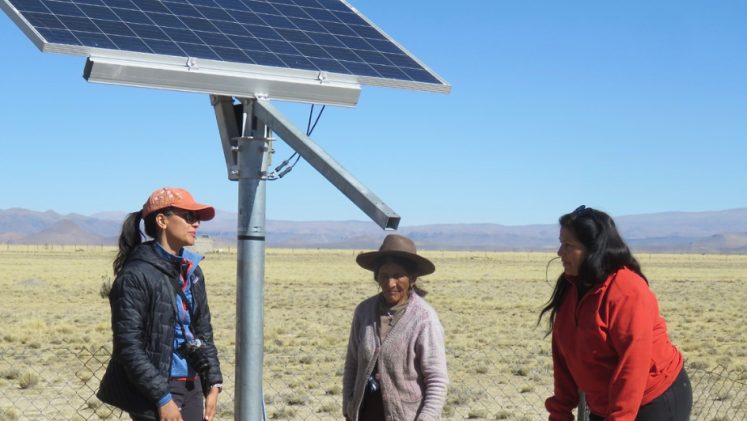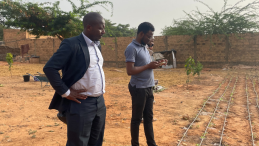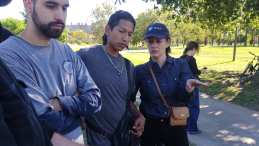Who: Lina Rodriguez, Research Associate at the Global Mountain Safeguard Research programme (GLOMOS), a joint division of UNU-EHS and Eurac Research
When: 19 – 30 May 2025
Where: The Andes in Argentina and Colombia
Why: Evaluating successful climate change adaptation solutions in mountain regions.
Mountains are on the frontlines of climate change, which threatens ecosystems, water resources and the livelihoods of over a billion people who depend on them. However, the speed and scale of climate impacts are putting unprecedented pressure on these fragile environments. In this interview, we learn about Lina Rodriguez’s recent field mission to the Andes in Argentina and Colombia, through which she seeks to strengthen the resilience of mountain communities by knowledge-sharing and the assessment of effective climate adaptation strategies.
Can you briefly introduce your field mission?
I focus on Indigenous and local knowledge related to climate adaptation and disaster risk reduction in mountain areas. As part of my role within GLOMOS and my PhD under the Adaptation at Altitude programme, I help identify and assess successful adaptation solutions across the Andes. These solutions are shared in a solutions portal to connect science, policy and practice.
We selected five adaptation solutions in the Andes, and I recently visited mountain communities in Argentina and Colombia with our regional partner to evaluate implementation, community benefits, scalability and local perceptions, with the aim to identify good practices and feed into a global assessment.
What climate challenges are Andean communities facing?
In Colombia’s Lake Tota basin, the main pressure comes from intensive spring onion farming. This practice uses large amounts of water and pesticides, which stresses the lake and affects biodiversity and has led to land-use conflicts due to its intensity. Socioeconomic issues further drive dependence on agriculture. In response, communities are exploring sustainable tourism, especially birdwatching, as an economic alternative. It connects conservation with livelihoods and helps monitor species changes related to climate shifts.
In Argentina’s Jujuy province, we visited the high-altitude Puna region, a vast plateau that extends across northern Argentina, Bolivia, Peru and Chile. There, most rainfall occurs between December and February. Climate change is making rainfall more intense and irregular, while the rest of the year is drier.
The combination of increasingly intense rainfall, prolonged droughts, soil erosion and overgrazing contributes to the degradation of wetlands and flooded grasslands. When water comes, it further erodes soil and carves canyons through wetlands, reducing water distribution and threatening both ecosystems and the livelihoods of local communities. Wetlands International, together with local communities and authorities, uses nature-based solutions to enhance water retention and storage within the wetlands, allowing water to spread across the ecosystem and improve vegetation growth. This helps sustain livestock and restore ecological balance.
Can you describe how the mission helped you assess the solution regarding the building of resilience?
In Argentina, we saw excellent collaboration. Local authorities, NGOs and communities are all involved. The plan to improve water storage and retain it within the wetlands has clear benefits and communities say they now feel better prepared.
The installation of solar pumps also made it easier to access water. Previously, women spent whole days manually collecting water for their families and animals. Some families have around a hundred animals that drink two to three buckets of water per day. Imagine how their lives improved through these seemingly small interventions that have big daily impacts and reinforce resilience.
How do local cultural dynamics influence these solutions?
Communities are well-organized and deeply knowledgeable about their environment. Local leaders often coordinate across remote areas and people understand the land, the soil and seasonal shifts. Indigenous and local knowledge remains incredibly relevant and continues to evolve. Such knowledge has sustained communities to survive for centuries. The fact that they are still there, adapting and thriving, is proof of its value.
What were some key lessons you gathered from your interactions during field interviews?
Success begins with meaningful community involvement. When projects start by asking people what they need and respecting Indigenous and local knowledge, communities are motivated to engage. We saw strong coordination, local autonomy and a desire to continue building on what works. Also, the people who stay in these regions despite harsh conditions play a key role. When they see benefits from nature-based solutions, they may inspire younger people to return or re-engage with their land.
What do you hope policymakers take away from your findings?
Trust is essential. Work with trusted organizations that already have strong community relationships. For example, our partner has worked in Jujuy for years. When we visited, locals welcomed us because of that connection.
Additionally, local communities must be involved from the start, not just consulted later. Inclusivity, long-term partnerships and coordination between communities, NGOs and governments are what make these solutions succeed.





